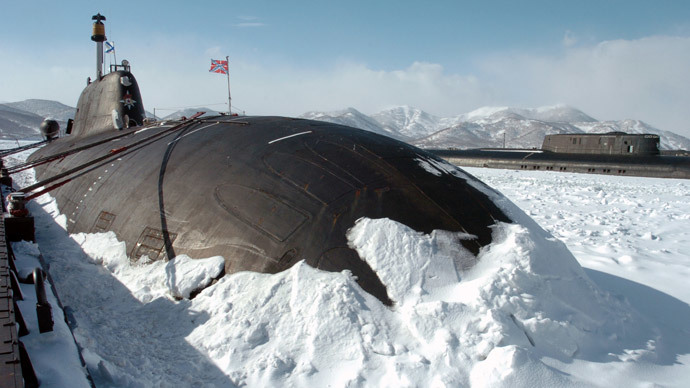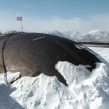
Russia Creates Arctic Military Command
Publication: Eurasia Daily Monitor Volume: 11 Issue: 215
By:

The Kremlin has created a new Arctic military command—the clearest and most practical signal yet of Russia’s long-term strategic stake in the High North. Russia’s military Arctic command became operational on December 1. The significance of the change in organizing the country’s military districts or (in wartime) joint strategic commands, the constitution of the first “Arctic” bases on Russian territory, as well as the implications of these initiatives are all explicit declarations of the strategic importance of the area in Russian security policy (Interfax, November 25; The Moscow Times, November 27).
Joint Strategic Command (Obedinonnye Strategicheskoe Komandovanie—OSK) North began functioning on December 1, following long-term planning to develop and expand military infrastructure and rehearse the protection of Russian interests in the Arctic. It brings the total number of OSKs in the Russian command military system to five. However, OSK North, unlike the others, appears not to function as a Military District in peacetime; suggesting it may serve in a more nuanced and “ready-to-act” disposition. President Vladimir Putin confirmed the anticipated move to create the Artic command, in terms of improving the “overall structure” of the Russian Armed Forces, and aimed to strengthen the state border and protect the country’s growing interests in the Arctic (Nezavisimoye Voyennoye Obozreniye, November 28).
Earlier, RIA Novosti reported that Russia had opened a second Arctic military base in environmentally protected territories. The second Arctic base is located on Cape Schmidt in the Far Eastern Chukokta region. Although the overall personnel size for the base has not been disclosed, defense ministry sources referred to a drone detachment for Arctic reconnaissance and the building of an airport in 2015. The first base was opened in Pechenga on the basis of the 200th Motorized Rifle Brigade (MRB). Two more Arctic bases will open in 2015, on Kotelny Island off the coast of Yakutia (a federal nature reserve) and Alakurtti village near the Finnish border, to host an MRB (The Moscow Times, November 27). As the command is reinforced and developed over the next few years with additional assets, there will be changes to the combat training year; most notably in the Air Force. “In 2015, main efforts of the Air Force will be directed to increasing of the presence in the Arctic zone, re-training of the personnel for new and modernized weaponry,” defense ministry spokesman Igor Klimov told reporters (Xinhua, December 2).
In political terms, the timing for the creation of the new command seems linked to the ongoing United Nations processes on managing the potential for dispute among the Arctic powers. Moscow has submitted a request to the UN to expand its Arctic territory by 1.2 million square kilometers. Russia wants to preserve its long-term energy interest in the Arctic and legitimize its territorial claims. One Russian source estimated that among 60 major oil fields in the Arctic, 43 are in the “Russian sector.” In the Kremlin’s estimation, this will require defense measures to protect Russia’s interests (Nezavisimoye Voyennoye Obozreniye, November 28).
The idea of creating Russian military Arctic-focused structures had long been mooted; but in December 2013, Defense Minister Sergei Shoigu declared the plan to form the new Arctic command based on the Northern Fleet. Moreover, in his recent statement, Putin confirmed that the Northern Fleet forms the basis of the new “all-arms” forces assigned to OSK North. Further indications that the defense ministry was serious about such plans emerged in March 2014, with the elite airborne forces conducting a para-drop on the Novosibirsk Islands (Lenta.ru, October 2). In September 2014, Deputy Defense Minister Colonel-General Dmitry Bulgakov said that the new Arctic command would be spearheaded by the withdrawal of the Northern Fleet from OSK West. Bulgakov stated that specialist equipment for the Arctic bases and fuel and supplies would be delivered, as infrastructure plans advance (Voyenno-Promyshlennyy Kuryer, September 10).
Quite apart from the anomaly of the fifth OSK not having Military District status in peacetime, the realization of the ambitious plans for the command may prove to be problematic. Indeed, the huge territorial coverage of the command and the potentially hazardous operational conditions will place limits on its formation. Apart from the core force of the Northern Fleet, defense ministry sources indicate air forces, ground forces, aerospace defense forces, as well as specialist units such as electronic warfare will be included; but these will be dispersed and cover several thousand kilometers of polar coastline in their area of responsibility. One priority, for example, will be to greatly expand the numbers of coast guard units involved in the new command. In any future crisis, strategic mobility will be key, as well as coordinated action by the Navy in terms of naval infantry and the use of military transport aircraft (Lenta.ru, October 2).
Although OSK North remains in its infancy, a number of points are worth observing, especially in the context of Russia’s Arctic policy. The based formations are relatively modest. The overall force mix and any unforeseen problems that emerge suggest that it may be some time before OSK North emerges in anything like its final form. The references to “withdrawing” the Northern Fleet to form its basis may also be misleading; in real terms, this means that part of the Northern Fleet HQ will be co-located with the new OSK North. Otherwise OSK West would weaken. It is unclear how these new structures will integrate into the overall organizational system, but it seems that the fifth OSK may prove to be a “poor brother” in relation to the other commands (Voyenno-Promyshlennyy Kuryer, September 10).
The formation of OSK North, long planned and the result of considerable careful avoidance of appearing to “militarize” the Arctic, has occurred during Russia’s crisis with the United States and the North Atlantic Treaty Organization (NATO) over Ukraine. That crisis has fully demonstrated Moscow’s willingness to act in defense of its perceived national security interests, even if such actions prove unpopular or bring further economic hardship. In this sense, forming the Artic command signals to Russia’s Arctic partners that it will act if necessary to defend its interest in the Arctic. But like its relatively low-scale military involvement in Ukraine has shown, the Kremlin is learning that a smaller-scale military footprint could be enough to at least make a potential adversary think twice concerning possible disputes in the Artic.




